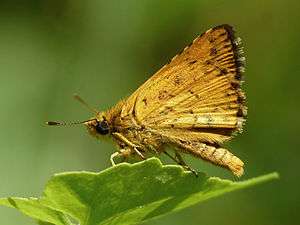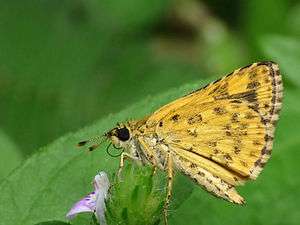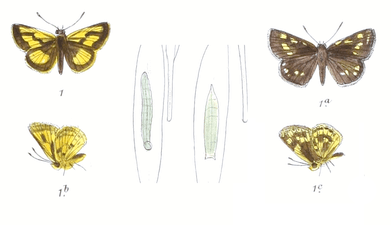Ampittia dioscorides
Ampittia dioscorides, the common bush hopper or simply bush hopper,[1][2][3][4][5] is a butterfly found in India, China, Indochina, Cambodia and on to Borneo, Sumatra and Java belonging to the family Hesperiidae.[6][7][1]
| Common bush hopper | |
|---|---|
.jpg) | |
| A. d. dioscorides in Kerala, India | |
 | |
| Male in Kerala, India | |
| Scientific classification | |
| Kingdom: | |
| Phylum: | |
| Class: | |
| Order: | |
| Family: | |
| Genus: | |
| Species: | A. dioscorides |
| Binomial name | |
| Ampitta dioscorides (Fabricius, 1793) | |
Description
Male. Upper.side. Forewing bright golden-yellow, costal line black, outer margin with a broad even black band, slightly but squarely bulged inward at the hinder angle, a broad black baud on the hinder margin with two golden-yellow spots in it, one a little before the middle, the other a little beyond the middle; a black band running up from the middle of the hinder marginal band to the costa one-third before the apex, throwing out a cross band from above its middle and joining the marginal
band; in some examples this diseal band is disconnected from the costa from the crossbar. Hindwing blackish-brown, with an irregular-shaped, short, broad, diseal, golden yellow band, composed of spots divided by the veins, the two centre ones elongated, the lower ones small. Cilia brown, touched in parts with golden-yellow, especially at the anal angle. Underside. Forewing as above, but the extreme outer margin is more or less golden-yellow. Hindwing with the ground colour golden-yellow, most of the wing covered with minute brown scales, the diseal patch as above, edged with pale in-own, and a series of pale brown sub-marginal spots all round the wing from the base to the anal angle. Antennae black, ringed with yellow, the cIub yellow on the underside and at the tip; palpi, head and body brown above, palpi and head marked with yellow, all yellow beneath.
Female. Upperside dark brown. Forewing with a yellow spot at the end of the cell, and a diseal series of yellow spots, two, sometimes three, divided by the veins, from near the costa, one-sixth from the apex, two in the middle of the disc in the median interspaces, and a small one in the interno-median interspace, an indistinctseries of sub-marginal yellowish spots on the upper half of the wing. Underside paler. Forewing with the spots as above put larger, a yellow sub-costal streak from the base to beyond the middle. Hindwing with many minute yellow scales in parts, a discal series of yellowish spots and a sub-marginal series.
Subspecies
- A. d. dioscorides Ceylon, Peninsular India, Calcutta, Sikkim to Assam, Burma[1]
- A. d. etura (Mabille, 1891) Vietnam, Hainan, South Yunnan, Taiwan
- A. d. camertes (Hewitson, 1868) Burma, Thailand, Laos, Yunnan, Malaysia, Singapore, Borneo, Sumatra, Nias, Java, Bali
 Male
Male Female
Female Mating pair; male right, female left
Mating pair; male right, female left Illustration
Illustration
| Wikispecies has information related to Ampittia |
| Wikimedia Commons has media related to Ampittia dioscorides. |
References
- R.K., Varshney; Smetacek, Peter (2015). A Synoptic Catalogue of the Butterflies of India. New Delhi: Butterfly Research Centre, Bhimtal & Indinov Publishing, New Delhi. p. 41. doi:10.13140/RG.2.1.3966.2164. ISBN 978-81-929826-4-9.
- http://animaldiversity.ummz.umich.edu/accounts/Ampittia_dioscorides/classification/
- "Archived copy". Archived from the original on 2016-08-20. Retrieved 2014-03-18.CS1 maint: archived copy as title (link)
- http://www.ifoundbutterflies.org/285-ampittia/ampittia-dioscorides
- "Archived copy". Archived from the original on 2014-08-04. Retrieved 2014-03-18.CS1 maint: archived copy as title (link)
- W. H., Evans (1949). A Catalogue of the Hesperiidae from Europe, Asia, and Australia in the British Museum. London: British Museum (Natural History). Department of Entomology. p. 239.
-
